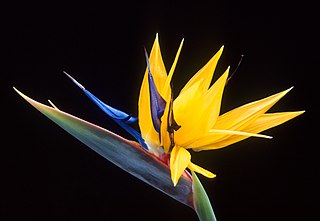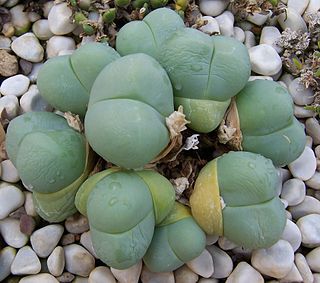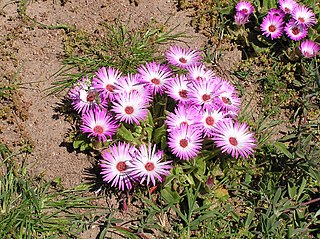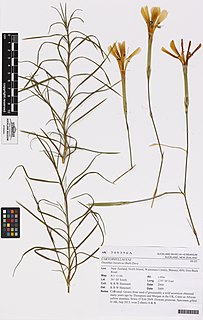
Strelitzia is a genus of five species of perennial plants, native to South Africa. It belongs to the plant family Strelitziaceae. The genus is named after Queen Charlotte of the United Kingdom. A common name of the genus is bird of paradise flower/plant, because of a resemblance of its flowers to birds-of-paradise. In South Africa, it is commonly known as a crane flower and is featured on the reverse of the 50-cent coin. It is the floral emblem of the City of Los Angeles; two of the species, S. nicolai and S. reginae, are frequently grown as houseplants.

Freesia is a genus of herbaceous perennial flowering plants in the family Iridaceae, first described as a genus in 1866 by Christian Friedrich Ecklon (1886) and named after the German botanist and medical practitioner, Friedrich Freese (1795-1876). It is native to the eastern side of southern Africa, from Kenya south to South Africa, most species being found in Cape Provinces. Species of the former genus Anomatheca are now included in Freesia. The plants commonly known as "freesias", with fragrant funnel-shaped flowers, are cultivated hybrids of a number of Freesia species. Some other species are also grown as ornamental plants.

The Aizoaceae, or fig-marigold family, is a large family of dicotyledonous flowering plants containing 135 genera and about 1800 species. They are commonly known as ice plants or carpet weeds. They are often called vygies in South Africa and New Zealand. Highly succulent species that resemble stones are sometimes called mesembs.
Bulbine namaensis is a species of plant in the genus Bulbine. It is native to Namibia and to the Cape Provinces in South Africa. Its natural habitat is dry savanna.

Gibbaeum is a genus of about 21 species of small succulent plants of the family Aizoaceae, indigenous to the Little Karoo region of South Africa. The name "Gibbaeum" comes from the Latin gibbosus (hunchback)
Prosphytochloa is a genus of African plants in the grass family. The only known species is Prosphytochloa prehensilis, native to Eastern Cape Province, KwaZulu-Natal, Swaziland, Mpumalanga, and Limpopo.
Pseudopentameris is a genus of South African plants in the grass family, found only in Western Cape Province.
Bewsia is a genus of African plants in the grass family. The only known species is Bewsia biflora, widespread across much of sub-Saharan Africa from Ivory Coast to Tanzania to KwaZulu-Natal.
Megaloprotachne is a genus of African plants in the grass family. The only known species is Megaloprotachne albescens, native to Angola, Zambia, Zimbabwe, Botswana, Namibia, and South Africa

Cleretum is a genus of flowering plants in the family Aizoaceae, native to the Cape Provinces of South Africa.

Dianthus basuticus, called the Drakensberg carnation, Lesotho carnation, Lesotho pink, hlokoa‑la‑tsela in the Sesotho language and Lesothose wilde angelier in Afrikaans, is a species of Dianthus native to South Africa and Lesotho. It is a near-endemic of the Drakensberg Alpine Centre, and occurs predominantly on rocky, grassy slopes, from Avontuur and the Kammanassie mountains in the Western Cape, through the Eastern Cape and into KwaZulu-Natal Province.

Wooleya is a monotypic genus of flowering plants belonging to the family Aizoaceae. It only contains one known species, 'Wooleya farinosa'(L.Bolus) L.Bolus It is also in Tribe Ruschieae.

Vanheerdea is a genus of flowering plants belonging to the family Aizoaceae. It is also in Tribe Ruschieae.
Hammeria is a genus of flowering plants belonging to the family Aizoaceae.
Jacobsenia is a genus of flowering plants belonging to the family Aizoaceae.
Stayneria is a genus of flowering plants belonging to the family Aizoaceae. It just contains one species, Stayneria neilii(L.Bolus) L.Bolus It is in the Subfamily of Ruschioideae and Tribe of Ruschieae.
Rabiea is a genus of flowering plants belonging to the family Aizoaceae.
Marlothistella is a genus of flowering plants belonging to the family Aizoaceae.
Peersia is a genus of flowering plants belonging to the family Aizoaceae.
Spatalla mollis, the woolly spoon, is a flower-bearing shrub that belongs to the genus Spatalla and forms part of the fynbos. The plant is native to the Western Cape, South Africa.







